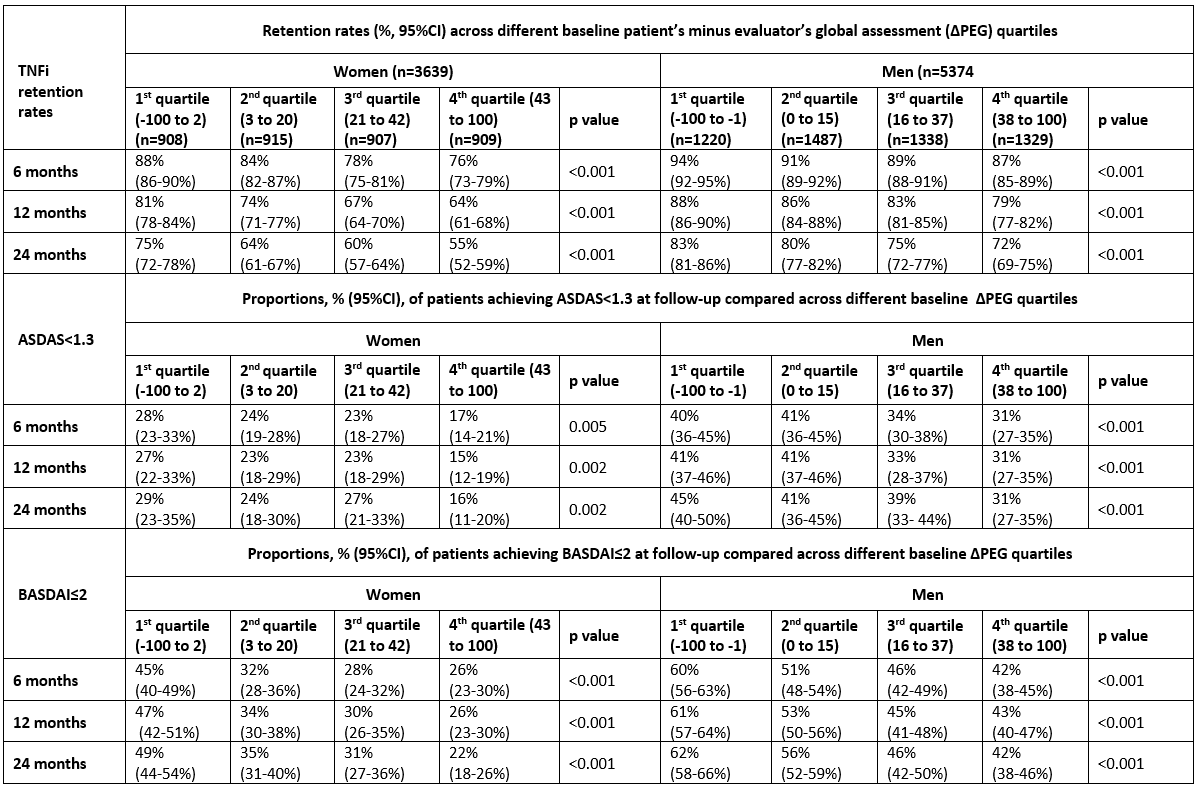Session Information
Date: Sunday, November 10, 2019
Title: 3S076: Patient Outcomes, Preferences, & Attitudes I: Patient Reported Outcomes (833–838)
Session Type: ACR Abstract Session
Session Time: 2:30PM-4:00PM
Background/Purpose: Discordance between baseline patient’s and evaluator’s global assessment of disease activity is common.1 However, the impact of such discordance on retention and remission rates of TNF inhibitor (TNFi) therapy in axial spondyloarthritis (axSpA) patients remains unexplored. Hence, the aim of this study was to assess the impact of baseline discordance, defined as “patient’s minus evaluator’s global assessment of disease activity” (ΔPEG), on retention and remission rates of a first TNFi in axSpA patients across Europe.
Methods: AxSpA patients from 10 European registries participating in the European Spondyloarthritis Research Collaboration Network (EuroSpA) were included. Retention rates after 6/12/24 months’ treatment with first TNFi were assessed with Kaplan-Meier analyses, with comparison between baseline ΔPEG quartiles with log rank test, stratified by gender. Proportions of patients in BASDAI remission (≤2) and ASDAS inactive disease (< 1.3) after 6/12/24 months for different ΔPEG quartiles were compared with Chi-square test, stratified by gender.
Results: A total of 9013 axSpA patients were included. Mean (SD) age for women (n=3639)/men (n=5374) were 42.7(12.0)/41.7(12.0) years, disease duration 5.1(7.4)/6.9(8.7) years, median (25-75 percentiles) baseline ΔPEG 20(3-42)/15(0-37) mm. TNFi retention rates and proportions of patients achieving BASDAI≤2 and ASDAS< 1.3 after 6/12/24 months were lower for higher quartiles of ΔPEG (table, figure).
Conclusion: In patients receiving their first TNFi, high baseline patient’s compared with evaluator’s global assessment is negatively associated with retention rates as well as proportions of patients achieving BASDAI remission and ASDAS inactive disease after 6, 12 as well as 24 months follow-up, both in female and male axSpA patients. TNFi retention rates were lower for women than for men at all timepoints.
To cite this abstract in AMA style:
Michelsen B, Midtbøll Ørnbjerg L, Loft A, Kvien T, Ciurea A, Mann H, Eklund K, Yazici A, Santos M, Askling J, Rotar Z, Gudbjornsson B, Pombo-Suarez M, Codreanu C, van der Horst-Bruinsma I, Kristianslund E, Nissen M, Pavelka K, Trokovic N, Inanc N, Vieira-Sousa E, DiGuiseppe D, Tomsic M, Geirsson A, IONESCU R, van de Sande M, Iannone F, Sánchez-Piedra C, Jones G, Hyldstrup L, Lund Hetland M, Østergaard M. Does Discordance Between Baseline Patient’s and Evaluator’s Global Assessment of Disease Activity Impact Retention and Remission Rates of a First TNF Inhibitor in Patients with Axial Spondyloarthritis? Data from the EuroSpA Research Collaboration Network [abstract]. Arthritis Rheumatol. 2019; 71 (suppl 10). https://acrabstracts.org/abstract/does-discordance-between-baseline-patients-and-evaluators-global-assessment-of-disease-activity-impact-retention-and-remission-rates-of-a-first-tnf-inhibitor-in-patients-with-axial-s/. Accessed .« Back to 2019 ACR/ARP Annual Meeting
ACR Meeting Abstracts - https://acrabstracts.org/abstract/does-discordance-between-baseline-patients-and-evaluators-global-assessment-of-disease-activity-impact-retention-and-remission-rates-of-a-first-tnf-inhibitor-in-patients-with-axial-s/


